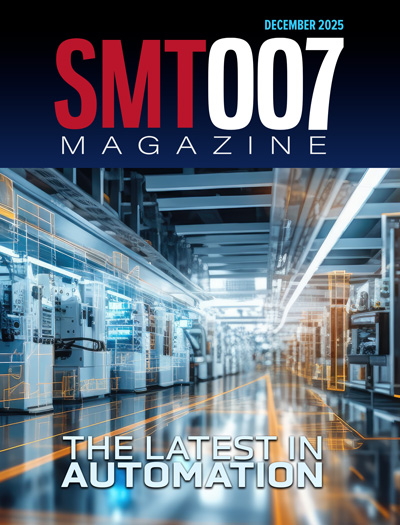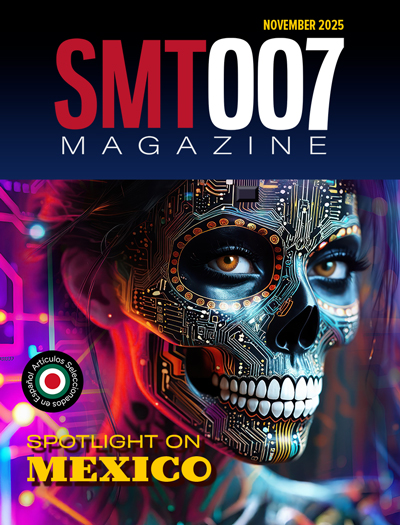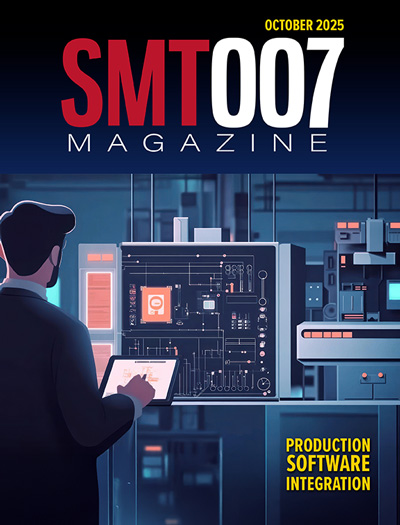-

- News
- Books
Featured Books
- smt007 Magazine
Latest Issues
Current Issue
The Latest in Automation
When customer requirements shift, responses range from new equipment to automation. Explore the newest solutions reshaping production and how today’s market dynamics are driving these trends.

Spotlight on Mexico
Mexico isn’t just part of the electronics manufacturing conversation—it’s leading it. From growing investments to cross-border collaborations, Mexico is fast becoming the center of electronics in North America. This issue includes bilingual content, with all feature articles available in both English and Spanish.

Production Software Integration
EMS companies need advanced software systems to thrive and compete. But these systems require significant effort to integrate and deploy. What is the reality, and how can we make it easier for everyone?
- Articles
- Columns
- Links
- Media kit
||| MENU - smt007 Magazine
Book Excerpt: The Electronics Industry’s Guide to… The Evolving PCB NPI Process, Chapter 1
September 28, 2022 | I-Connect007 Editorial TeamEstimated reading time: 2 minutes
Chapter 1
How the NPI Process Has Changed and Where We're Going
When forging into unknown territory or exploring new ground, it can help to look at where we’ve been so we can orient ourselves.
Just a few decades ago, electronics manufacturing companies were producing high volumes of few products. The efficiency of electronics manufacturing lines is measured by overall equipment effectiveness (OEE) and total effective equipment performance (TEEP). Back then, this meant optimizing the time it took to build a single board. If the time it took to build one board could be reduced by a few seconds, the savings would be multiplied by the number of boards being built. This could be in the hundreds of thousands or millions of boards, with no changes in the line configuration. If it took a day to change over from one product to another, it didn’t matter because the TEEP/OEE was driven by the time it took to build a board.
For example, consider that it takes 35 seconds to place components on a single board, and I need to make 250 boards. My handling time (the time it takes to load a board into the machine and get it out after) is 10 seconds, then the total time to build the 250 boards will be (35 + 10) • 250 = 11,250 seconds. This equates to about 188 minutes, or approximately three hours. If it takes four hours to changeover—namely reconfigure the line before starting a different PCB—to a new product, my OEE will be less than 50%, considering no other external factors. As the batch size goes down, the changeover time dominates the OEE figure.
In today’s high-mix, low-volume production environments, performance is further enhanced with line efficiency. Line efficiency is the ratio of the number of hours during which a high-volume, pick-and-place machine places parts on the PCB, divided by the number of hours during which the SMT assembly lines are staffed (placement time/staffed time x 100). It is a solid number, simple to obtain, and has great value as a key performance indicator.
With higher product mixes, the number of NPIs being processed increases. Changeovers on the shop-floor line can happen daily or many times a day. This also means the time it takes to process the source design data has increased. This data-processing time is becoming a more important consideration compared to when NPI processing was not a daily task in the lower mix environment. As product mix has gone up, there has been a move from mixed vendor lines focused on ultimate through-put to single vendor lines focused on flexibility and shorter changeovers. There may be more than one pick-and-place vendor brand in the factory, but each line commonly has only one brand now.
Download your free copy today! You can also view other titles in our full library.
We hope you enjoy The Electronics Industry’s Guide to… The Evolving PCB NPI Process.
Testimonial
"Your magazines are a great platform for people to exchange knowledge. Thank you for the work that you do."
Simon Khesin - Schmoll MaschinenSuggested Items
Real Time with... productronica 2025: The Versatility of Electroplating Technology With GreenSource
12/01/2025 | Real Time with...productronicaGustavo Ramos from GreenSource Engineering shares insights on an innovative electroplating module. This system features high current density and adaptable chemistry, making it suitable for a range of applications. The focus is on developing a flexible process that can handle various product mixes and technologies, enhancing efficiency and versatility in electroplating.
Real Time with... productronica 2025: KYZEN's Approach to Innovative Cleaning Solutions for Electronics
12/01/2025 | Real Time with...productronicaIn this interview by Pete Starkey at productronica 2025, Jayson Moy shares insights on KYZEN's environmentally responsible cleaning products tailored for the electronics industry. Their discussion covers the challenges of meeting European market demands and adapting to regulations. KYZEN introduces products like the AQUANOX A4618, focusing on custom solutions and process control systems that ensure chemical concentration reliability.
productronica 2025: Showcasing the Future of Electronics Manufacturing for 50 Years
11/25/2025 | Marcy LaRont, I-Connect007Last week’s productronica 2025 at Messe München in Munich marked a significant milestone for the European electronics manufacturing industry. The biennial show celebrated its 50th anniversary, highlighting five decades of technological transformation as the largest global trade fair for electronics manufacturing. Co-located with Semicon Europa, productronica attracted an attendance of over 47,000 visitors, featuring more than 1,600 exhibitors from over 50 countries.
Technica USA Welcomes Peter Chen as Director of Service
11/24/2025 | Technica USATechnica USA is proud to announce that Peter Chen has joined the company as Director of Service.
Strong Signal for the Industry: productronica 2025 Drives Positive Industry Trend
11/21/2025 | productronicaFrom November 18 to 21, over 1,600 exhibitors from 52 countries met at productronica to present innovations in electronics development and production.


